
| Jacket 40 — Late 2010 | Jacket 40 Contents | Jacket Homepage | Search Jacket |

Susan Howe
This piece is about 18 printed pages long.
It is copyright © Antoine Cazé and Jacket magazine 2010. See our [»»] Copyright notice.
The Internet address of this page is http://jacketmagazine.com/40/howe-s-caze.shtml
Back to the Susan Howe feature Contents list
When I was a schoolchild, my first English textbook, edited by P.-M. Richard & Wendy Hall (L’anglais par l’illustration, 1972), had cartoon-like images on the left-hand-side pages and the text of the corresponding lesson on the right-hand-side ones. In class, we were required to use an opaque black plastic flap, or interleaf, to mask the text so that we had no choice but to speak about the images with the few words we had at our disposal. The temptation to lift the flap was permanent and great, so tied were we to the written transcriptions of sounds, to imagining sound shapes as letters only, to making sense with language.
I can still feel the slightly grainy texture of the plastic interleaf between finger and thumb, imprinted in my memory at the same time as the early rudiments of English. This feeling is there, connecting visual images to mental ones suggested by sounds, then turned into words. Matching image to word to sound to sense?

terleaf between frontispiece and title page in order to pre-
vent illustration and text from rubbing together. Although a
sign is understood to be consubstantial with the thing or be-
ing it represents, word and picture are essentially rivals. The
transitional space between image and scripture is often a
zone of contention.
— The Midnight
How does a writer account for these connections/contentions?
Observe the etching lines of “THE SECOND OLDEST VIEW OF BUFFALO,” a reproduction offered as the frontispiece to Frame Structures.
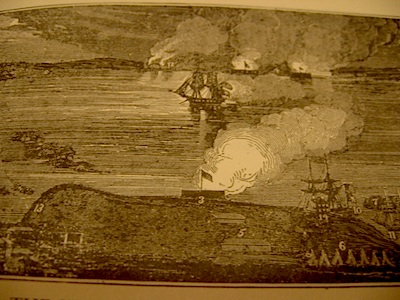
See how their preindustrial grid echo the hard crisscrossing metal of the Wharf Sculpture on the book’s cover.
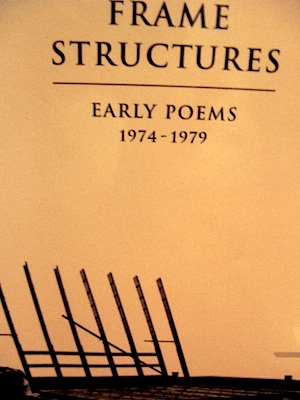
The busy lines of a night battle in 1812; the cool, detached industrial lines of a foggy morning “overlooking Boston Harbor” in 1972. See again how the silhouetted ship looming into sight from the right-hand side on the book cover announces the horizontal shapes to the right of the engraving.

Boston to Buffalo to Boston, crossings, crisscrossing, framing the early years of Susan Howe’s life 1937-1941. Frames for these structures; visuals framing dates framing histories, 1812-1941, naval battles.

Observe how the waving lines in the Buffalo engraving clear up in the middle so that the thickest part of the smoke plume issuing from the cannon is expressed visually by an absence of lines: the blank hole in the image opens onto nothingness because it is meant to block the view of the dark-lined stretch of water lying behind. In effect, it redirects the viewer’s gaze elsewhere, to another space of memory, obscured by plumes of war smoke
Women and children experience war and its nightmare. Their war-dreams share with dreams of other kinds that they are occurrences full of blown sand seaward foam in which disappearance fields expression.
[… ]
Clouds must have come under the western edge of the old suspension bridge.
Frame Structures
“Disappearance fields expression”―what expression gets distributed, fielded, through disappearance on this field? This battlefield of language? It is the obscuring part that leads to the expression, making sense come under and out of the disappearance it provokes.
The relation between this blank hole at the center of the image―a disappearance which is the thick of the battle (the fog of history)―and the vanishing signs of the text is the focal/fog-all point of Susan Howe’s pages in her books; it concentrates the fields of her pages as multidimensional battles of signs, visual and linguistic tangle.
B u f f a l o
12.7.41
(Late afternoon light.)
the Open
power of vision a vast
zero
The Europe of Trusts
Flanders
On Sunday, December 7, 1941, I went with my father to the zoo in Delaware Park even now so many years after there is always for me the fact of this treasured memory of togetherness before he enlisted in the army and went away to Europe.
Frames Structures
So, this blank spot in the middle of the engraved battle can only yield to other lines, lines of text, lines of writing that loom through the hole in the image, on the other side of the page, glimpsed in the opaque transparence of an absence. Engraving the “treasured memory” through image in(to) text.
A transfer.
This “view” of Buffalo at war in 1812―in which nothing of the city is actually viewable―“directly” short-circuits through the page to Flanders (WWI) and on to Pearl Harbor (WWII), looming up overleaf. It transfers us there.
How does one transfer from image into text? And back? Can one superimpose these two categories without transgressing or trespassing into territory that threatens to engulf one? Without risking to vanish in the process? Becoming ghosts?
coincidence produces an optical ghost or guess
Frame Structures
GHOST enters WAVES he
The Europe of Trusts
GHOST: 10 b. A shadowy outline or semblance, an unsubstantial image (of something); hence, a slight trace or vestige
c. An impression of a signature made by folding the paper over while the ink is still wet.
COINCIDENCE: The fact or condition of being coincident; the occupation of the same place or part of space. “There can be no Coincidence in the Eye, or Visual Point.” (Francis Bacon, Sylva, 1677, §244) [… ] “The singleness of the picture arises from the coincidence of the two pictures.” (Sir David Brewster, Memoirs of the Life of Sir I. Newton, 1855).
INCIDENCE: Physics. The falling of a line, or anything moving in a line (as a projectile, a ray of light, heat, etc.) upon a surface; the manner of such falling, esp. in regard to the inclination of the line of incidence to the surface.
1704 NEWTON Opticks (J.), In equal incidences there is a considerable inequality of refractions.
OED
The incidence of drawn lines as they fall onto written lines.
Therefore, as One returned, I feel
Odd secrets of the line to tell!
Emily Dickinson, Fr132
An incident here and there,
and rails gone (for guns)
from your (and my) old town square
H.D., Trilogy
By TransParencies, I do not mean any simple superimposition of image and text, or any obvious access to the two sides, twin sides, of a document; rather, TransParencies require the effort of going through the appearances (impressions, ghosts) of image & text and focusing on the layering work Susan Howe’s books effect. Focusing on the page itself as a trans/action, a field of possible displacements, refractions: not abstracting from its material texture, but taking into account all its incidents, traversing it as the forest it once was, “Taking the Forest”
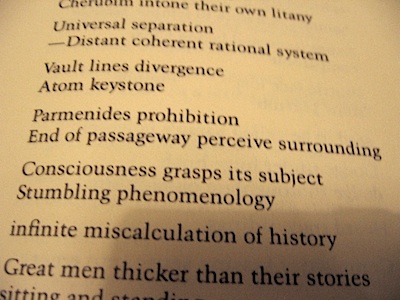
End of passageway perceive surrounding
Consciousness grasps its subject
Stumbling phenomenology
“Taking the Forest,” Articulation
To place one’s reading at the point of coincidence between image and text, which is the page, and observe the “inequality of refractions.”
To obscure these transparencies; to observe on the obverse side what “gathers in the missing.”
Historical imagination gathers in the missing
Frame Structures
This blank spot in the oldest view of Buffalo, at once whitened out & obscuring, gives onto the block of text overleaf, a text which specifically “gathers in the missing”: our gaze is absorbed through the page and through time, from (not) seeing to (mis)reading, bleary blurred by intervening snapshots of what is not shown except in our mind’s eye.
Lines represent the limits of bodies encompassed by the eye.
Frame Structures
Porosity Poetry Sorority History
n
PorHiStOrorEtrY
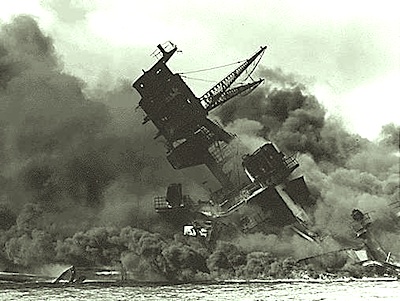
Pearl Harbor – USS Arizona ablaze
“Historical imagination gathers in the missing”―that is, some areas of fact or experience are left blank, or inarticulate, un-discoursed by the language of history itself, very much like a reserve in a painting, through which one can see the picture’s ground or even the canvas showing. An optical call is made for images to surface in the missing; fragments seen through this gathering. Like a clear patch of sky amongst gathering clouds? Or like billowing, obscuring clouds, “must have come under the western edge of the old suspension bridge.”
This suspension, in the missing.
This is the way I see the historical vignette opening Frame Structures: it superimposes WWI (Flanders) over WWII (Pearl Harbor), itself partly erased from view by the zoo scene described in this first fragment of childhood memories, itself worked together with vast notions of liberty & violence; shifting ceaselessly from foreground to background, in and out of focus, like the white bears in the zoo, and also, crucially, like the sentences themselves whose missing commas allow unexpected meaning to gather along sudden corridors of twisted syntax:
Animals sense something about ruin I think he said our human spirits being partly immaterial at that prefigured time though we didn’t know then how free will carries us past to be distance waiting for another meeting a true relation.
Frame Structures
Everything, then, is a question of such a “true relation”―narration and links, broken or impaired both.
The relational work accomplished by the image comes from the fact that the visual material is treated textually, and the other way around; visual material interacts with textual material, each displacing the other into different frame structures, a concomitant disembodiment and rematerialization of signs as they become differently spaced, both framed and unframed.
Absence is always present in a picture in its right relation. There is a split then how to act. Laws are relations among individuals.
Frame Structures
What kind of absence do these relations bear, or bear the traces of? How is it possible to express the relational work of history? That is to say, how can texts tell the way in which history―when perceived and transcribed not in its master narratives of grandiose coherence, but more correctly in its relation with our “real” lives―impacts the intimacy of these our lives?
In his recent book The Privation of Intimacy, Michael Foessel defines intimacy as a relational space specifically designed to favor a certain kind of in/visibility:
Intimacy means the sum of relations someone decides to subtract from the social space of exchange in order to preserve themselves from them and build their life experience sheltered from other people’s gazes. The space of intimacy therefore results from an act by which a subject decides to subtract part of himself and his relations from the domain of shared visibility.
Foessel (my translation)
The relational space is the thing that’s alive with something from somewhere else.
— The Midnight
There is this endless fascination in Susan Howe’s work for the capacity to relate widely disjointed fragments in such a way that they do connect into a sense of intimacy, touching the precise spot at which historical events become meaningful for each of us without ever yielding to the seductions of the grand design, aka History. This retreat into a domain of different, intimate, visibility is accomplished by spacing out one’s relations with shared experiences in a medium allowing for transparency. This medium is the transactional space of the page as such. Because the page is this thin, semi-transparent surface of paper, it allows for all kinds of “sub-scripts” (the term is Alan Golding’s in “Susan Howe’s Visual Poetics,” We Who Love to Be Astonished, 154) or partial visibilities to surface, which Howe’s books not only take as their topics but actually enact in their very design and composition.
The Materials. Leafing through.
Observe Susan Howe’s propensity to superimpose blocks of texts or images, or a combination of both, that take up exactly the same space on either side of a book’s page.
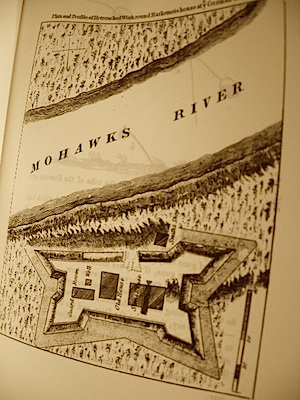
For instance, the two frontispieces to Thorow in the French edition: the frame of the “Plan & Profile” conditions the layout of the second plate, which fits entirely (except for one “potato” shape sticking out at the top) inside the ghost frame appearing in transparency.
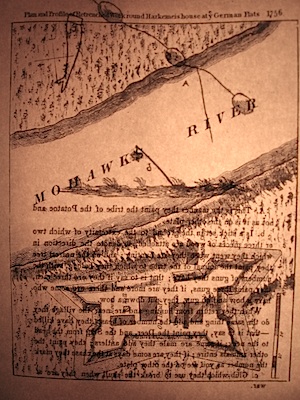

Couldn’t we see in this an attempt at figuring the through-ness of an intermediary, relational space? An attempt at inhabiting the same space and yet not the same, that side un/framing this side, the flux of drawings challenging the fixity of text
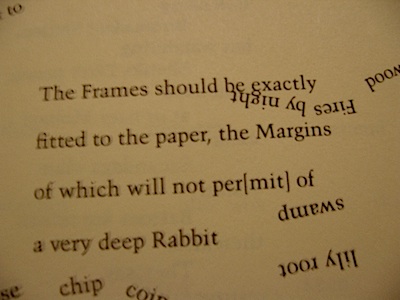
The Frames should be exactly
fitted to paper, the Margins
of which will not per[mit] of
a very deep Rabbit
“Thorow”, Singularities
Or again, observe on p.73-4 of The Midnight, how the two images shadow across each other, the interleaf looming on the frontispiece to Stevenson’s book reduplicated as a page looming obliquely across Alice in Wonderland―one translucent white, the other black.
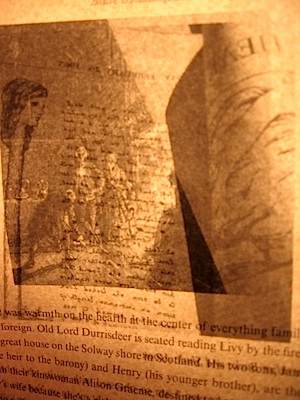
What kind of transaction is taking place in the trans-apparition of these folded pages?
When reading Susan Howe’s books, I cannot resist seeing the coincidental ghost of text shapes piercing through their pages; the page becomes a field of shifting frames for shapes/shades that are simultaneously, trans/parent/ly, text and image.
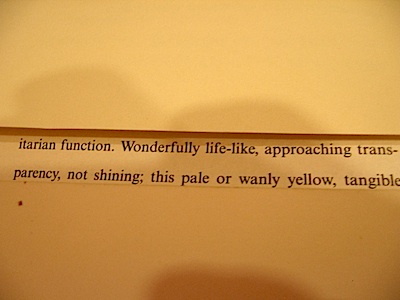
each spectral scrap intact in a handed down book has ac-
quired an enchanted aura quite apart from its original util-
itarian function. Wonderfully life-like, approaching trans-
parency, not shining;
— The Midnight
“Scrap” into “script”?
SCRAP: 2. A remnant; a small detached piece; a piece very small by comparison with the whole; a fragmentary portion.
b. Of immaterial things, conversation, literary compositions, etc.
Observe for instance how, in The Midnight, “Bed Hangings I,” blocks of texts can be seen in transparency, superimposed upon each other from page to page, in sequences of 8, then 9, then 10 lines.
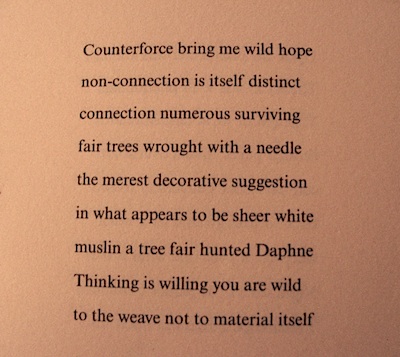
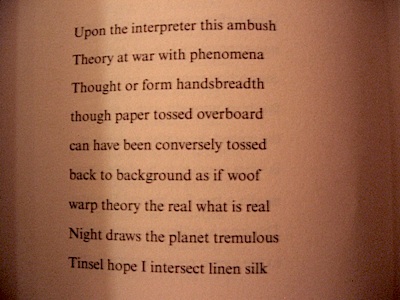
There is a slight gap in the alignment of each text upon the other that makes them appear, in transparency, as projected shadows, or ghost images, of one another. Co-incidental.
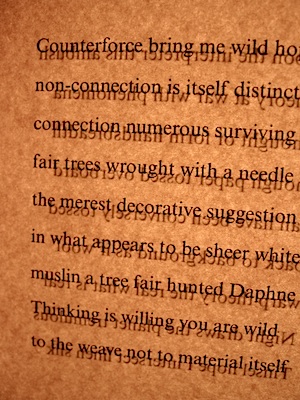
Transparency is not “clarity”: quite the contrary, Howe’s superimposition of images & texts preserves both the possibility of a transfer (in the graphic art sense of the word) and the blur imparted by the remaining, or spectral, contours of “shadow documents”―which is to say, crucially, alternative versions of the historical records Howe mostly works with & through. The important point here is that these documents can be called “shadows” because of their material contribution to the space of the page: the page becomes a trans-material support for the re-inscription of displaced histories, or even better the history of displacements: the removes of Mary Rowlandson & of Hope Atherton, for example.
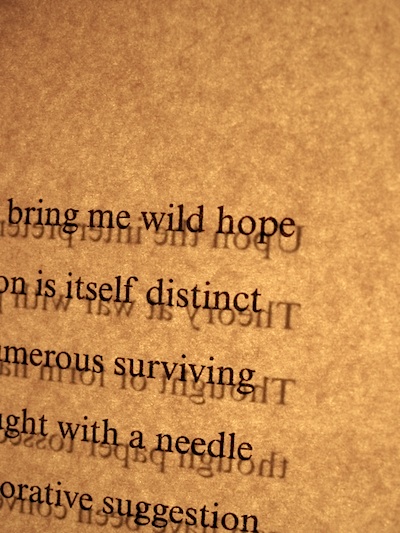
Dis/spacements
This textual condition I feel like an invitation to read through the pages, un-foliating their bi-dimensional surface to produce depth: “Glide my shadow through”―a spectral text hangs among those pages, which invites the reader to feel them as potential interleaves, insubstantial corridors to suspend the apparition of our meanings in, hangings in the dark rooms of our imagination:
quick rustling. If a piece of sentence left unfinished can act
as witness to a question proposed by a suspected ending, the
other side is what will happen.
— The Midnight
Precisely, it is the other side as event, as happening, that carries the full force of Susan Howe’s page as a relational space. Hanging “unfinished” on one side, her words need to be transferred to the other side in order to “happen.” The book becomes this space of constant reciprocal projection, intersection of happenings in the very grain of the paper, the reader trying to perceive these transactions/relations, to capture them through the paper, literally.
Counterforce bring me wild hope Upon the interpreter this ambush
non-connection is itself distinct Theory at war with phenomena
connection numerous surviving Thought or form handsbreadth
fair trees wrought with a needle though paper tossed overboard
the merest decorative suggestion can have been conversely tossed
in what appears to be sheer white back to background as if woof
muslin a tree fair hunted Daphne warp theory the real what is real
Thinking is willing you are wild Night draws the planet tremulous
to the weave not to material itself Tinsel hope I intersect linen silk
AMBUSH: [a. OFr. embusche-r, embuissier, cogn. w. Sp. embuscar, It. imboscare:late L. *inboscre, f. in in + bosc-us wood, BUSH, i.e. to place in a wood, or among the bushes.]
A military disposition consisting of troops concealed in a wood or other place, in order to surprise and fall unexpectedly upon an enemy.
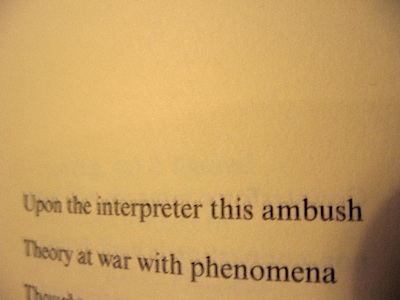
This texts ambush reading―in the thicket of overleaf connections between signs of primeval meaning, we are redirected to the actual trees of this pages, “fair trees wrought with a needle.” A book is made by sewing trees together.
Thought paper, though paper, through paper.
Daphne, turned into the laurel, the emblem of Apollo.
hope Upon
Tinsel itself (self/selve/wood)
TINSEL: 2. A kind of cloth or tissue; tinseled cloth; a rich material of silk or wool interwoven with gold or silver thread; sometimes apparently, a thin net or gauze thus made, or ornamented with thin plates of metal; later, applied to a cheap imitation in which copper thread was used to obtain the sparkling effect.
TINSEL: Brushwood for hedging or fencing.
The field of forces created by these words and shapes is remarkable: our perception of this pages is torn between reading words for their meanings and seeing words for their shapes, “Theory at war with phenomena.” The beauty of these page lies in their constant interleaving of the two acts, reading and seeing, making us relate with the space of this multifoliated text as the actual event, rather than its telling: we are plunged in the condition of “intersect linen silk”, the lines of this linen/page woven at level of each letter, pen stroke, inflection.
The tissue interleaf in Ballantrae serves as a whisper and a stage direction. Kinship―sensationally, not linked as each would be if overscored. Folie à deux? Perhaps. A sentence is one unit but inside are two separate syntactic units.
— The Midnight
the interleaf beckons you back
— The Midnight
So this is my imagined space for the transactions of Susan Howe’s pages:
Interleaf
Leafing through
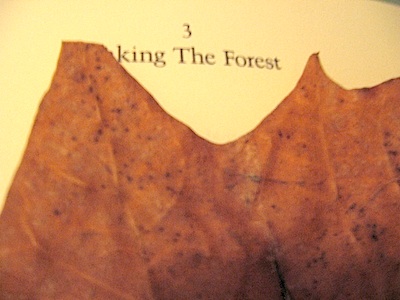
Laying the foundation for an ecology of the page, its conservation / conversation from text to picture from picture to text
Paper is made from trees
To find/delineate the kind of book space that would let the reader see through to the trees: rematerialize paper into forests
To find the kind of language space that would “curtain” the world in translucent material
To page the world into meaning
This means creating a foliated space
Pierced th(o)rough
:
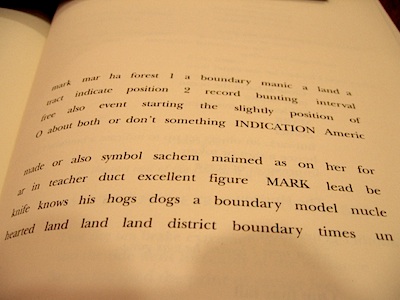
the field of this poem (Frame Structures, 89), artificially and yet necessarily bounded on each side by a typographical hedge, bears on each of its line the scars of a territorial battle waged to mark off the land, the words (woods, woofs) serving as so many signposts signaling boundary positions, or milestones. This surveyor’s work (Thoreau) is challenged by the poetic un-linearity of the “leaking” lines themselves, pierced or “maimed” with holes through (Thorow) which meaning constantly threatens to flow out. The poem is a compact, compressing in its two-dimensional format the layers of several, incompatible dimensions, spatial and temporal at once―a transgression of lines, a transparent thicket of words.
Setting up the page as a recursive space of text in which a self (selve/wood) may appear, folded, as a relational nexus countervailing the linearity of historical accounts.
A folio.
Every mortal has a non-communicating material self―a waistcoat or embroidered doublet folded up, pressed down, re-folded to fit snugly inside. Incommunicado. Words sounding as seen the same moment on paper will always serve as the closest I can come to cross-identification vis-à-vis counterparts in a document universe. I’m only a gentle reader trying to be a realist. Can you hear me?
The Midnight
Folie à deux?
As at the end of Frame Structures, framing the book, the line, and at the same time unframing them into the material shape of a signature

sh woof subdued toward foliage free sh
Frame Structures
This signature, twice, folded in both text (woof) and texture (foliage)
sh. The signature―this sign, this nature, transparently framing this structure
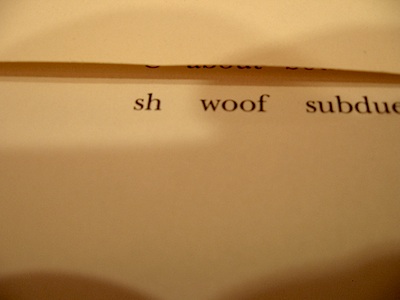
Similarly, the obliterated text on p.78 of The Midnight lets the author’s signature stand out at the bottom, vertically, the “s” separated from the “h” by a comma.
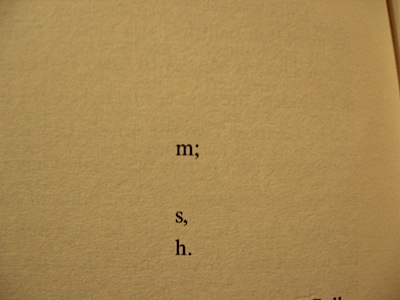
Am(bu)sh
SH her being in the folded paper of this bu SH
A partially visible subject – A parentally visible subject – Trans/Parent
A par(en)t (share/distribution) is made invisible (indivisible?) by this partial visibility
A common ground, foliated, is hypostasized in the opaque TransParency both connecting and dividing text and image
It is the burden of such SHaring that Susan Howe’s lines worry
(All photos © Antoine Cazé, except the two black and white pictures from Pearl Harbor)
DICKINSON, Emily. The Complete Poems of Emily Dickinson. Ed. by Ralph W. Franklin. Cambridge, MA: Harvard UP, 1998.
DOOLITTLE, Hilda. Trilogy. Ed. with an introduction by N.H. Pearson. Manchester: Carcanet, 1973.
FOESSEL, Michael. La privation de l’intime. Paris: Le Seuil, 2008.
HOWE, Susan. Frame Structures: Early Poems, 1974-1979. New York: New Directions, 1996.
———. Singularities. Middletown, Ct: Wesleyan UP, 1990.
———. The Europe of Trusts. Los Angeles: Sun & Moon Press, 1990.
———. The Midnight. New York: New Directions, 2003.
———. Thorow. Translated into French by Bernard Rival & Dominique Fourcade. Paris: Théâtre Typographique, 2002.